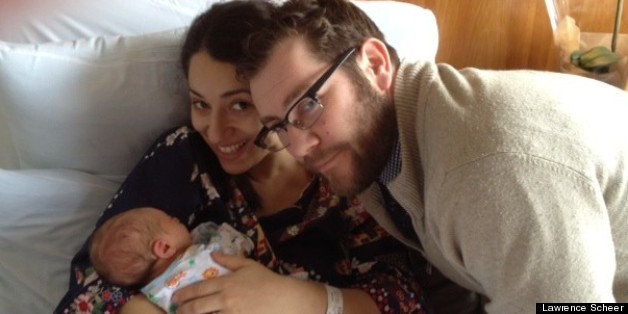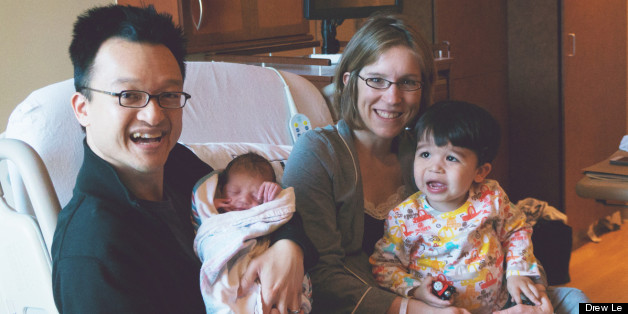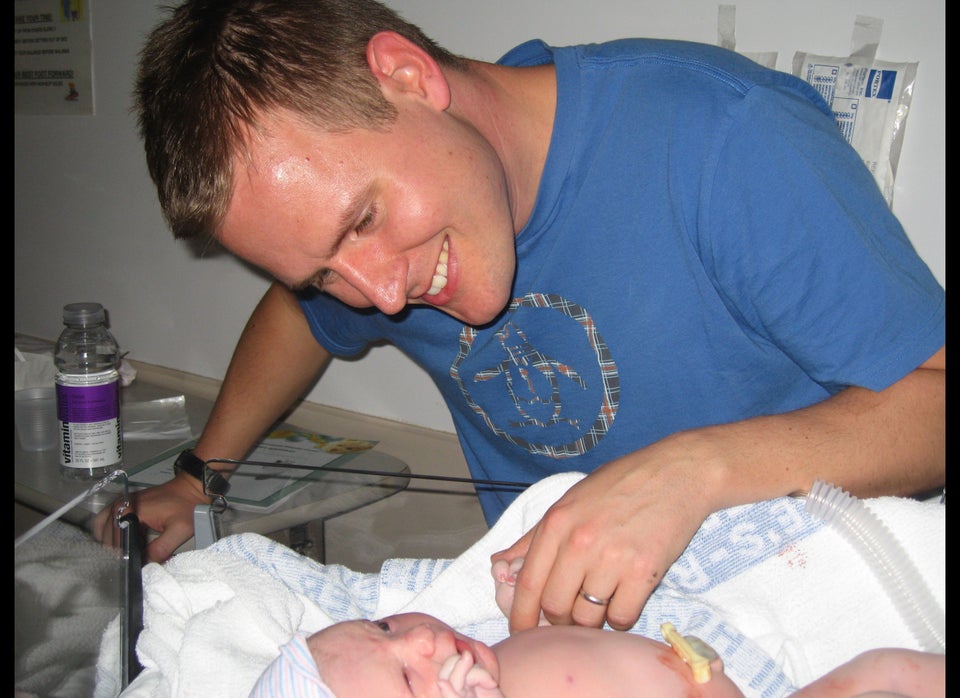
Before his daughter was born 13 months ago, Nathan Timmel teased his pregnant wife, Lydia Fine, telling her he would not step foot in the delivery room.
"I thought, 'It'll be like the 1950s. I'll be hanging out in a bar, not seeing anything gross,'" Timmel, a 43-year-old comedian, joked at the time.
But when Fine's contractions started three weeks early, her husband was glued to her side, pressing her left leg back while she pushed and even peeking as the baby emerged -- something he said he'd never do. "I thought, 'Wow, I'm literally looking at the grossest thing I'll ever see,' but I didn't care," Timmel said, laughing. "I was watching my child be born."
For Timmel, threatening to stay out of the delivery room turned out to be a bluff, but other dads-to-be say they long for the days when men got to skip the blood and the screaming and just show up when there was a clean, bundled baby to hold. For many American couples, it's important -- and expected -- for the man to be fully present throughout the birth. But in some dark corners of the Internet, on blogs and forums, women confess that their squeamish significant others would prefer simply to stay in the waiting room. Are those partners the weak, outmoded black sheep of modern parenthood? Or has society gone too far in expecting all dads to be active participants -- through labor, pushing, crowning -- while giving them little clear guidance on why, exactly, they're there?
Throughout the early 20th century, American women gave birth at home with the help of female relatives, friends and midwives. "Men were completely not related," said Ziv Eisenberg, a researcher with Yale University's History Department. As hospital births took over, partners were confined to the waiting room, or "stork club" -- because doctors and nurses didn't want anyone bothering them. Having another person in the room also increased the risk of infection, said Eisenberg.
It wasn't until the mid-1960s and early 1970s, with the advent of second-wave feminism and Dr. Robert Bradley's seminal book Husband-Coached Childbirth, that dads started to get involved. "In the 1930s, if your wife was in labor, it was okay for you to be at Yankee Stadium watching a game," said Eisenberg. "Now, there's a cultural expectation that husbands will be in the delivery room."
It might be an expectation, but there's still relatively little guidance for fathers and partners. The tendency is to think that men should suck it up, because women do all the real work, said Elissa Stein, author of Don't Just Stand There: How to Be Helpful, Clued-In, Supportive, Engaged, Meaningful and Relevant in the Delivery Room. But, Steinberg said, this tendency is problematic. "The woman is often in pain and scared," she said. "The partner's never been through it, either."
While pregnant with her second baby, Stein put together a pamphlet for her husband, Jon, that eventually turned into her book. Her first birth was difficult. As doctors struggled to find the baby's heartbeat, Jon stood to the side, panicked. Eventually he picked up the camera, hoping to be useful in some way. When Stein later saw the photos, she was horrified: "I was like, 'OH MY GOD. You did not take that picture!' But he did -- a whole bunch of them, really intimate stuff," she said. Dads aren't dolts, Stein added, but they don't always know how to be a meaningful part of labor.
Research suggests it's important for partners to get guidance, especially after a difficult birth. When a team from Oxford University interviewed 10 men and one woman whose partners had experienced life-threatening complications during birth, they found that all of them were "deeply affected" by the experience, and at least one even experienced subsequent depression and post-traumatic stress disorder.
"We are not suggesting that fathers should be less involved in childbirth, but [we are] calling for a greater awareness of the impact that these births can have on both the mother and the father," said study researcher Lisa Hinton.
Even increasingly routine scenarios can unnerve partners. Lawrence Scheer, 37, who co-founded Magnificent Baby (a clothing company) and who was not involved in the Oxford study, said he was "terrified" when his wife, Marina, was wheeled toward the operating room for a cesarean section seven months ago. "The whole time they're down there cutting her up, and she's moving -- I could see her being jerked around by the cutting and poking and tearing," he said. "It was pretty traumatic."

The outcome was a happy one, but Lawrence Scheer said that witnessing his wife's C-section was difficult.
The most extreme voice in the "dads in the delivery room" debate is French obstetrician Dr. Michel Odent, who argues that men should not be in the delivery room -- period. Odent published a research paper claiming that the presence of fathers, or men in general, during delivery limits a woman's production of oxytocin, slowing labor and increasing the likelihood of cesarean delivery. But the evidence supporting that claim is scant at best, and most birthing experts disagree.
"I think all partners should participate," said Dr. Chavone Momon-Nelson, an OBGYN with the University of Pennsylvania Health System. "I don't think you ever regret participating, but I do think you regret missing your child's birth." In nearly a decade on the job, Momon-Nelson has never dealt with a partner outright refusing to be present during the birth, she said, but she has encountered partners whose apprehension is palpable.
"Sometimes they have that glassy look in their eye, especially if it's someone who gets a little nervous if they see blood," she said. "I say, 'If you're feeling a little nervous, sit down, stay toward the head of the bed, because the overall experience will be there even if you don't watch.'"
Sometimes watching a partner give birth is too much for even the most enthusiastic dad-to-be. When his son, who is now 2 years old, was born, Drew Le, a 34-year-old music professor, was doing fine until the anesthesiologist appeared to administer the epidural. The physician took out the needle and tried to insert it into his wife's back several times. "By the third poke, I was getting light-headed," Le said. "The anesthesiologist turned to me and said, 'Lie down on the floor and close your eyes.' So there I am, lying on the cold hospital room floor." His laboring wife just laughed, he said.
After he recovered from his wooziness, Le worried that he wouldn't be able to handle the birth itself, but the process ended up being "so fascinatingly beautiful," he said. "My adrenaline and excitement and love for my wife and that new, living creature overpowered any squeamishness I might have had."
Several months ago, when his second baby was born, Le took some precautions. When the anesthesiologist came in, he left the room, returning only after the epidural was administered.

Drew Le learned his lesson, stepping out for the epidural when his second baby was born.
This story appears in Issue 71 of our weekly iPad magazine, Huffington, available Friday, Oct. 18 in the iTunes App store.
